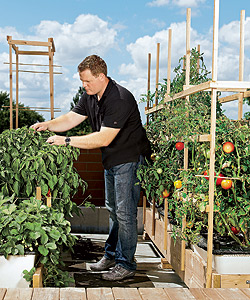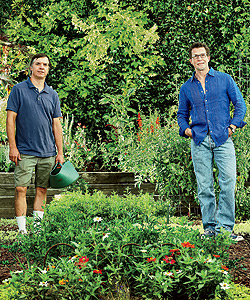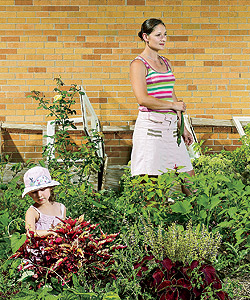|
|
RUSS CHEATHAM
Russ Cheatham’s roof is hot. It’s also sunny, dry, and windy—kind of like a desert, in fact. Yet somehow Cheatham has managed to overcome these harsh conditions and raise a crop of food so bountiful that last summer he went for weeks-long stretches without visiting a grocery store.
“We [had] too much food,” Cheatham says of the harvest he shared with his wife, Alyssa. “Even if there was a family of four there’d be too much food.” Last year, he gave away gallon bags full of romaine and red sail lettuce and still, he says, “It was salads every night—salads with chicken, salads with tuna, salad with a sandwich.” Two visiting aunts went home with 20 tomatoes, and this reporter took an enormous bouquet of basil, parsley, rosemary, and thyme, all cut from month-old plants that were already the size of small shrubs.
Not bad for a guy who counts his time as a gardener in months, not years. Cheatham is the kind of passionate amateur cook who gets Jacques Pepin and America’s Test Kitchen DVDs as gifts, but he’d never tried growing more than a few dried-out pots of tomatoes until last year, after moving to the Ukrainian Village condo that he and his wife now share with their nine-month-old son, Henry. “I think the pursuit of becoming a better home cook has led me to try to source the best ingredients available,” Cheatham says. “Grocery stores are horrible. Farmers’ markets are great, but they’re once a week and they’re really expensive.”
Cheatham’s roof has a 150-square-foot area separate from the deck the couple uses for entertaining, and he began to wonder whether, as he says, “an urbanite with zero farmable land could grow food.” His research quickly led him to the EarthBox, a two-and-a-half-foot long, foot-high planter made of reusable plastic. This planter is, essentially, idiot-proof. As long as the 2.2-gallon reservoir in the bottom of the box remains filled through a watering tube in its corner, the soil on top stays moist. Fertilizer laid on top of the soil at the beginning of the growing season provides a steady source of nutrients, while a plastic cover that looks like a shower cap goes over the whole shebang, to hold moisture in and keep weed seeds out.
Cheatham’s mother happens to live in Bradenton near the EarthBox research center—Cheatham describes it as basically two guys, a trailer, and a lot of EarthBoxes—so he swung by on a visit to Florida last spring. “After seeing these things in action, with mini-coconut trees in them, cauliflower the size of soccer balls, I was sold,” Cheatham recalls. He went home and ordered a dozen of the planters online at earthbox.com. In early May, he planted starts of tomatoes, lettuce, onions, eggplant, peppers, cucumbers, zucchini, and strawberries; by June the garden was already bushy. Although Cheatham uses only organic potting mix and fertilizer, he bought most of his nonorganic seedlings at places like Home Depot, partly as a timesaver, partly to see if the standard-issue plants most people grow would do well.
Though he routinely logs 50-hour weeks working from home as an executive-search consultant, Cheatham says that, aside from a weekend spent lugging 40-pound bags of organic potting mix to the roof and building troughs to hold the boxes for extra wind resistance, maintaining the garden required remarkably little effort. “I’m not going to do anything difficult, because my wife and I work a lot of hours,” he says. (She’s an investment consultant.) With the EarthBoxes, he says, “You just water—then you’re done. It literally takes ten minutes a day. You almost try to find work for yourself.”
Cheatham claims not to be any kind of urban-gardening activist, but he and a few other rooftop gardeners in the neighborhood have started a blog, Green Roof Growers (greenroofgrowers.blogspot.com), in an effort to educate and inspire other city residents. “Look around—there are flat roofs everywhere, and they’re just sitting there,” he says, gesturing toward the dozens of rooftops surrounding his home. “Put them to use. I would love to see this in the food-desert neighborhoods of Chicago.” He laughs off the suggestion he may one day find himself to be a guru of rooftop gardening. “Ah, I hope not,” Cheatham says. ”I think you just show people it can be done and next thing you know, they go do it.”
Photograph: Andreas Larsson
|
|
RICK BAYLESS
You might think the acclaimed chef, restaurateur, and cookbook author Rick Bayless chose his house for its kitchen, the one TV viewers know so well from his weekly PBS cooking show, “Mexico: One Plate at a Time.” But Bayless has a passion for gardening, and it was his desire to create an urban farm that led him to the Bucktown abode he has shared with his wife, Deann, and now 17-year-old daughter, Lanie, for the past 13 years.
Owner of the restaurants Topolobampo and Frontera Grill, Bayless comes from three generations of restaurateurs and grocers, but he can’t say precisely how he developed an enthusiasm for growing food. “It’s like saying, ‘Now, why did you fall in love with that person and not that person?’” he explains. “I’ve always loved gardening.”
Even apartment living didn’t deter Bayless. For 20 years, he created container gardens, including one on the 17th floor of a Lake Shore Drive high-rise, where he built troughs on the terrace for vegetables and herbs. “I’ll tell you—that is hard gardening,” he recalls. “It’s constant wind off the lake and 100 percent sun all the time. After a while, nothing really thrives.”
When Bayless was ready to move to ground level, he knew what he was looking for. “I wanted a place I could live in town and feel was beautiful,” he says. “But I also wanted enough space to do a production garden for the restaurant.” After several years of searching, the Baylesses finally found their dream home, a converted brick tavern on a triple lot. A two-story-high vine-smothered concrete wall, the remnant of an abandoned Canadian Pacific rail line, runs along the north side, enabling the Baylesses to create the feeling of a secret sunken garden, one with meandering pathways that lead to an outdoor kitchen, a large grapevine-covered deck for entertaining, and a secluded gazebo with a day bed for lounging.
“It just makes me feel settled when I come here,” Bayless says of his garden. “Anybody that works in the restaurant world, you know it’s a very physically demanding, high-paced profession. When you plant something, it’s weeks, if not months or a full season, to come to full fruition. This offers a lot of balance for me in my life.”
The section of the garden devoted to producing food for the restaurants blankets roughly 1,000 square feet directly behind the home. It’s an urban farmer’s dream, beautifully designed and pristinely maintained by Bill Shores, Bayless’s full-time gardener for the past three years. Bayless credits Shores, a low-key, soft-spoken guy with a graduate degree in plant biology and a background in intensive, small-scale organic food production, with making the garden such an integral part of what his restaurants offer.
“Before Bill, the garden was productive, but there was no vision. No forward motion to think beyond what we were doing,” Bayless says. “Bill brought the garden into the now, really raising the standard of what the garden means to us and to our restaurants.”
One of Shores’s key decisions was to make salad greens the centerpiece. “That’s what I can produce in volume,” he explains. “They’re something [Topo-lobampo] uses at every meal, and they have a long growing season, so I can produce them from late March through early November out of the garden.” Nine beds of greens that, depending on the time of year, might include lettuce, cress, beets, mustards, red choi, or garland chrysanthemum, are laid out in a lovely patchwork of shades ranging from lime to moss. Shores grows some of them as microgreens, tiny leaves that are harvested year-round at just one to three weeks old and used for all the salads at Topolobampo, as well as for things like garnish on fish dishes. “Rick’s brought in a lot of Asian greens,” Shores says. “They have really assertive flavors, which he’s looking for. I go for different colors and textures.”
A well-controlled riot of herbs, edible flowers, chile peppers, and heirloom tomatoes borders the greens beds. Each growing season, Shores meets with Bayless and his managing chef, Brian Enyart, to talk over specific ingredients for new dishes. In all, the garden produces $25,000 worth of food a year, mainly for Topolobampo, but also for Frontera Grill.
Growing vegetables may be an exercise in letting go, but Bayless’s garden has room for attachment. He points out an enormous, 20-year-old sage bush he brought from his condo, a stand of rosemary given to him 15 years ago by one of the first farmers he worked with at the restaurant, and an oxalis he gave to Lanie when she was just two. “I’m very sentimental when it comes to plants,” he admits.
He’s also green, using only organic pest controls and fertilizers, including 700 pounds of worm castings produced in composting bins tucked along the side of the house. “We want to keep this soil very much alive, because it produces really vigorous and healthy plants, and [has done so] over a long period of time,” Bayless explains.
A student of yoga and ballroom dance, Bayless says that gardening has been his most humbling experience, and he advises other chefs to grow their own foods, because it will give them more respect for their ingredients. “Most people don’t realize how hard it is to do anything agricultural,” he points out. “You are pretty much prey to anything that comes by—pests, too much rain, too little rain, too much heat, not enough. It makes you realize that you’re not the director. You’re just a player, and your goal for success is to be a good player.”
Photograph: Andreas Larsson
|
|
MELINA KELSON-PODOLSKY
When does Melina Kelson-Podolsky sleep? Besides teaching full-time in the culinary arts program at Kendall College, running a catering business on the side, raising her young daughter, and training for marathons, Kelson-Podolsky somehow found the time last year to turn her entire corner lot in Skokie into an organic food garden. Does she sleep? She laughs off the question. “I’m not really capable of doing things small if I’m impassioned about them.”
No kidding. Here on her city-size lot, located on a busy street amid a sea of nondescript 1950s brick ranches, Kelson-Podolsky has planted roughly 115 different cultivars of vegetables, fruits, and herbs. The majority of what she grows began life as charmingly named heirloom seeds: Flame lettuce. Green Arrow peas. Mr. Stripey tomatoes. Unlike bland grocery-store vegetables, bred mainly to survive long-distance travel and extended stints in the produce aisle, these old-time varieties have been handed down through generations of gardeners primarily because they are deeply, intensely flavorful.
And Kelson-Podolsky clearly is first and foremost a foodie, prone to rhapsodic and detailed descriptions of what she grows, such as purple tomatillos that she says are “downright dessert-like-fruity with this sort of light, tomato-y essence on the finish.” She grew up the child of two food writers (Allen and Carla Kelson, who pioneered Chicago magazine’s restaurant criticism in the 1970s and ’80s); became a baker and pastry chef; and married a former chef for Levy Restaurants. Although she did go to a farm camp as a child, she was more into riding horses and milking cows than anything else. “I never thought of myself as someone with a green thumb,” Kelson-Podolsky says.
Nevertheless, she decided to plant a small plot of vegetables in the backyard after she and her husband bought their home in 2002. She wanted a garden mainly so she could grow “all kinds of crazy things I wouldn’t be able to find in the grocery store.” The whole thing really took off last year after Kelson-Podolsky attended a seminar by Growing Power, a nonprofit group that promotes urban agriculture. “It was a completely impulsive thing,” she says. “I started ripping out our ugly grass [to create planting beds]; I thought my husband was going to kill me.” One bed became four, which eventually became pretty much the entire yard except for daughter Jordan’s swing set—and its time is running out.
Surprisingly, people in the cars whizzing past Kelson-Podolsky’s home are unlikely to notice the bounty of food growing there. Wanting to avoid straight rows that would look too “farmy,” she instead created curvaceous beds with colorful thatches of cosmos, bee balm, and coleus planted among the produce. “I want to fit in the neighborhood,” Kelson-Podolsky explains. “I want it to be beautiful as well as practical.”
Initially she was concerned that the neighbors might object to such an unconventional use of the home’s public space, but the garden has proved to be an unexpected community builder. One day, she came upon an elderly woman sitting among the gooseberries and corn and arugula out front. The woman declined Kelson-Podolsky’s offer of help, saying, “I’m just enjoying the garden. Is that okay?” Another woman, who had never spoken to Kelson-Podolsky in the many times they had passed on a nearby running path, dropped by to give her an anise hyssop bush. And after pausing a half-dozen times during the installation of the front planting beds, a stranger around the corner announced he had rented a chainsaw to hack down his bushes. “I’ve never gardened before,” he told her, “but I’m putting in a garden.”
Nothing could delight Kelson-Podolsky more. “I think there’s a spiritual connection to growing your own food and being really engaged in the process,” she says. “Yesterday, one of my neighbors was asking what the collard was. To be able to break off a few stems and say, ‘Here, go home; this is how you cook it,’ and for them to know, ‘Hey, she was growing that on her front steps’—that’s deeply gratifying.”
Photograph: Andreas Larsson





